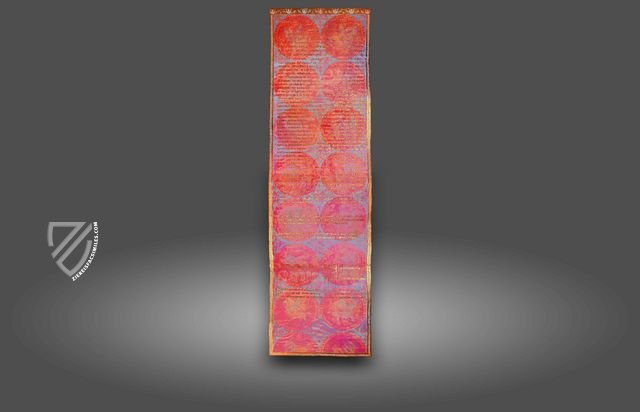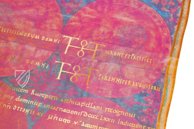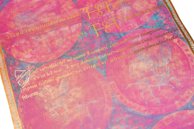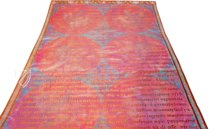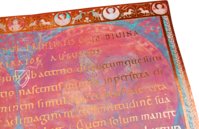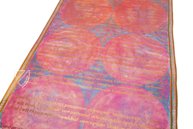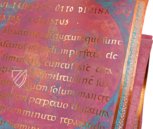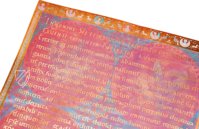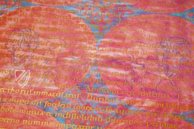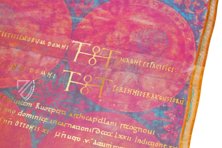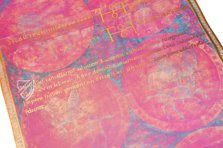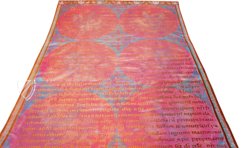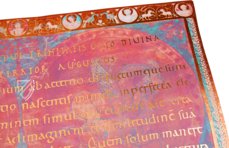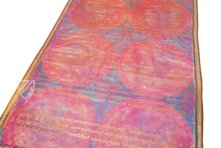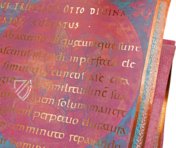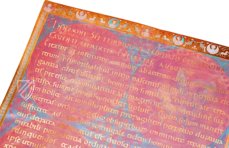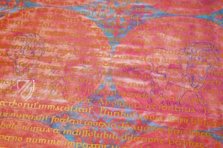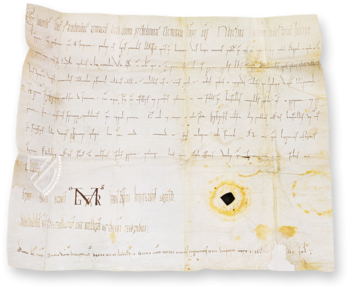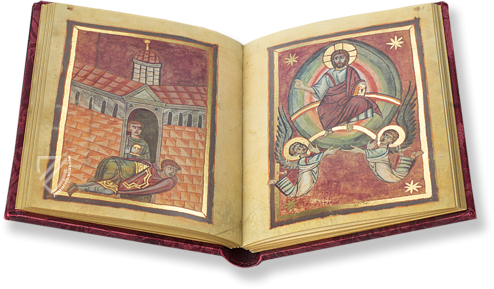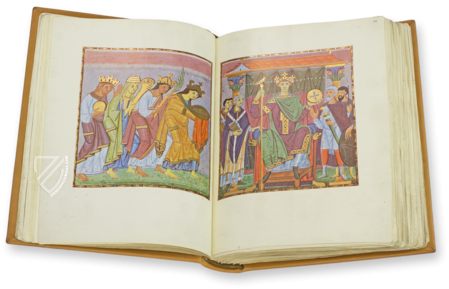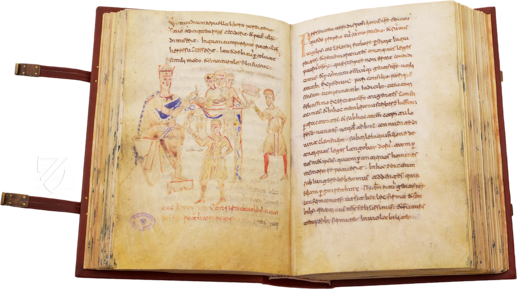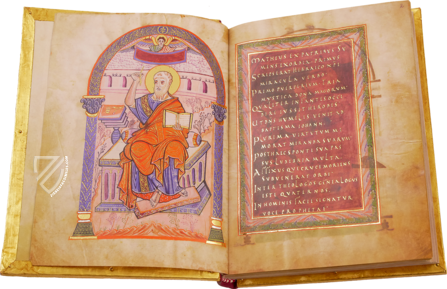Marriage Document of the Empress Theophano
(3,000€ - 7,000€)
The Marriage Certificate of the Empress Theophanu on the occasion of her marriage to the Roman-German Emperor Otto II in the year 972 constitutes an exceptional and unique document of the Ottonian era. The historical significance of the marriage certificate as an example of the connection of the Byzantine Empire with the occidental empire is indisputable. Nevertheless, its detailed artistic design and exceptionally valuable materials make the Marriage Certificate of Theophano a valuable relic of the Ottonian era.
Marriage Document of the Empress Theophano
The Marriage Certificate of the Empress Theophanu on the occasion of her marriage to the Roman-German Emperor Otto II in the year 972 constitutes an exceptional and unique document of the Ottonian era. The historical significance of the certificate as an example of the connection of the Byzantine Empire with the occidental empire is indisputable. Nevertheless, its detailed artistic design and exceptionally valuable materials make the certificate of Theophano a valuable relic of the Ottonian era.
A Marriage as a Political Event
In April 972 Pope John XIII married Otto II, the son of Emperor Otto I, and Theophano, the Byzantine princess, in St. Peter’s in Rome. With this above-all political act, a conflict between the Byzantine Empire in the East and the Carolingian Roman-German Empire in the West was diplomatically ended, which had existed since the imperial coronation of Charlemagne in the year 800. Each had raised a claim to the imperial title in the succession of the Roman Empire. The title for the Ottonian emperorship was to be made legitimate through the marriage between the two parties. On these grounds, Emperor Otto I married his seventeen-year-old son and co-emperor to the twelve-year-old niece of the Byzantine Emperor John I Tzimiskes, Theophano. The marriage certificate documents this event and its consequential legitimation, and furthermore, lays out the privileges due to the future empress. She was awarded the privilege to rule alongside her spouse and was additionally appointed the income and benefice due to her, including provinces and palaces in Italy, the Netherlands, and Germany. In the Gandersheim Abbey, which was strongly linked to the Empress Theophano personally, the certificate was stored and rediscovered in 1700. Gottfried Wilhelm Leibnitz, among others, already recognized the historical significance of the document early on.
Excessive Finery with Weighty Contents
The certificate is housed today in the Lower Saxon State Archive in Wolfenbüttel. The scroll on purple vellum is composed of three pieces stuck together and has an impressive format of 144.5 x 39.5 cm. The outer appearance of the very historically significant document gives an indication of its contents. Large circular medallions emboss the face of the certificate, which point to ornamental Byzantine patterns, some from expensive silk. In the purple circular area one finds the finest depictions of various animals, arranged in fighting pairs respectively. Among them one finds depictions of lions, deer, or horses. The surfaces between the medallions are colored with indigo, an additional substance of exceptional value. Artistic ornaments adorn these spaces. The whole document is framed by a circumferential golden decorative band with additional fine ornaments and even with small half-figure depictions of Christ, Mary, John the Baptist, and the Evangelists in the upper margin. The text of the marriage certificate is applied in Gold ink and the most beautiful script against the exuberant background. All of this splendor, together with the very historically significant content of the Marriage Certificate of Theophano, makes it one of the most unique art-historical specimens.
Codicology
- Alternative Titles
- Theophanu-Urkunde
Hochzeitsurkunde der Kaiserin Theophanu
Heiratsurkunde der Kaiserin Theophanu
Theophanu Hochzeitsurkunde
Theophanu Hochzeitsurkunde – Wolfenbütteler Stück
Marriage Certificate of Empress Theophanu
Wolfenbütteler Stück
Marriage Charter of Theophano - Size / Format
- 1 rotolus (composed of three parts) / 144.5 × 39.5 cm
- Origin
- Germany
- Date
- April 14th 972
- Epochs
- Language
- Script
- Carolingian minuscule
- Illustrations
- 14 circular medallions and 2 half medallions with scenes of animals fighting, gold border with blue and white acanthus leaves, the top edge of which is decorated with animals, vegetation, and small medallions depicting Jesus, Mary, John the Baptist, and the Four Evangelists
- Content
- Dower document for the Byzantine princess Theophanu
- Patron
- Holy Roman Emperor Otto II (955–983)
- Artist / School
- Gregory Master
- Previous Owners
- Empress Theophanu (ca. 955 –991)
Gandersheim Abbey
Göttingen State and University Library
Treasury of the Duchy of Brunswick
#1 Theophanu Urkunde
Language: German
(3,000€ - 7,000€)
- Treatises / Secular Books
- Apocalypses / Beatus
- Astronomy / Astrology
- Bestiaries
- Bibles / Gospels
- Chronicles / History / Law
- Geography / Maps
- Saints' Lives
- Islam / Oriental
- Judaism / Hebrew
- Single Leaf Collections
- Leonardo da Vinci
- Literature / Poetry
- Liturgical Manuscripts
- Medicine / Botany / Alchemy
- Music
- Mythology / Prophecies
- Psalters
- Other Religious Books
- Games / Hunting
- Private Devotion Books
- Other Genres
- Afghanistan
- Armenia
- Austria
- Belgium
- Belize
- Bosnia and Herzegovina
- China
- Colombia
- Costa Rica
- Croatia
- Cyprus
- Czech Republic
- Denmark
- Egypt
- El Salvador
- Ethiopia
- France
- Germany
- Greece
- Guatemala
- Honduras
- Hungary
- India
- Iran
- Iraq
- Israel
- Italy
- Japan
- Jordan
- Kazakhstan
- Kyrgyzstan
- Lebanon
- Liechtenstein
- Luxembourg
- Mexico
- Morocco
- Netherlands
- Palestine
- Panama
- Peru
- Poland
- Portugal
- Romania
- Russia
- Serbia
- Spain
- Sri Lanka
- Sweden
- Switzerland
- Syria
- Tajikistan
- Turkey
- Turkmenistan
- Ukraine
- United Kingdom
- United States
- Uzbekistan
- Vatican City
- A. Oosthoek, van Holkema & Warendorf
- Aboca Museum
- Ajuntament de Valencia
- Akademie Verlag
- Akademische Druck- u. Verlagsanstalt (ADEVA)
- Aldo Ausilio Editore - Bottega d’Erasmo
- Alecto Historical Editions
- Alkuin Verlag
- Almqvist & Wiksell
- Amilcare Pizzi
- Andreas & Andreas Verlagsbuchhandlung
- Archa 90
- Archiv Verlag
- Archivi Edizioni
- Arnold Verlag
- ARS
- Ars Magna
- ArtCodex
- AyN Ediciones
- Azimuth Editions
- Badenia Verlag
- Bärenreiter-Verlag
- Belser Verlag
- Belser Verlag / WK Wertkontor
- Benziger Verlag
- Bernardinum Wydawnictwo
- BiblioGemma
- Biblioteca Apostolica Vaticana (Vaticanstadt, Vaticanstadt)
- Bibliotheca Palatina Faksimile Verlag
- Bibliotheca Rara
- Boydell & Brewer
- Bramante Edizioni
- Bredius Genootschap
- Brepols Publishers
- British Library
- C. Weckesser
- Caixa Catalunya
- Canesi
- CAPSA, Ars Scriptoria
- Caratzas Brothers, Publishers
- Carus Verlag
- Casamassima Libri
- Centrum Cartographie Verlag GmbH
- Chavane Verlag
- Christian Brandstätter Verlag
- Circulo Cientifico
- Club Bibliófilo Versol
- Club du Livre
- CM Editores
- Collegium Graphicum
- Collezione Apocrifa Da Vinci
- Comissão Nacional para as Comemorações dos Descobrimentos Portugueses
- Coron Verlag
- Corvina
- CTHS
- D. S. Brewer
- Damon
- De Agostini/UTET
- De Nederlandsche Boekhandel
- De Schutter
- Deuschle & Stemmle
- Deutscher Verlag für Kunstwissenschaft
- DIAMM
- Droz
- E. Schreiber Graphische Kunstanstalten
- Ediciones Boreal
- Ediciones Grial
- Ediclube
- Edições Inapa
- Edilan
- Editalia
- Edition Deuschle
- Edition Georg Popp
- Edition Leipzig
- Edition Libri Illustri
- Editiones Reales Sitios S. L.
- Éditions de l'Oiseau Lyre
- Editions Medicina Rara
- Editorial Casariego
- Editorial Mintzoa
- Editrice Antenore
- Editrice Velar
- Edizioni Edison
- Egeria, S.L.
- Eikon Editores
- Electa
- Emery Walker Limited
- Enciclopèdia Catalana
- Eos-Verlag
- Ephesus Publishing
- Ernst Battenberg
- Eugrammia Press
- Extraordinary Editions
- Fackelverlag
- Facsimila Art & Edition
- Facsimile Editions Ltd.
- Facsimilia Art & Edition Ebert KG
- Faksimile Verlag
- Feuermann Verlag
- Folger Shakespeare Library
- Franco Cosimo Panini Editore
- Friedrich Wittig Verlag
- Fundación Hullera Vasco-Leonesa
- G. Braziller
- Gabriele Mazzotta Editore
- Gebr. Mann Verlag
- Gesellschaft für graphische Industrie
- Getty Research Institute
- Giovanni Domenico de Rossi
- Giunti Editore
- Graffiti
- Grafica European Center of Fine Arts
- Guido Pressler
- Guillermo Blazquez
- Gustav Kiepenheuer
- H. N. Abrams
- Harrassowitz
- Harvard University Press
- Helikon
- Hendrickson Publishers
- Henning Oppermann
- Herder Verlag
- Hes & De Graaf Publishers
- Hoepli
- Holbein-Verlag
- Houghton Library
- Hugo Schmidt Verlag
- Idion Verlag
- Il Bulino, edizioni d'arte
- ILte
- Imago
- Insel Verlag
- Insel-Verlag Anton Kippenberger
- Instituto de Estudios Altoaragoneses
- Instituto Nacional de Antropología e Historia
- Introligatornia Budnik Jerzy
- Istituto dell'Enciclopedia Italiana - Treccani
- Istituto Ellenico di Studi Bizantini e Postbizantini
- Istituto Geografico De Agostini
- Istituto Poligrafico e Zecca dello Stato
- Italarte Art Establishments
- Jan Thorbecke Verlag
- Johnson Reprint Corporation
- Josef Stocker
- Josef Stocker-Schmid
- Jugoslavija
- Karl W. Hiersemann
- Kasper Straube
- Kaydeda Ediciones
- Kindler Verlag / Coron Verlag
- Kodansha International Ltd.
- Konrad Kölbl Verlag
- Kurt Wolff Verlag
- La Liberia dello Stato
- La Linea Editrice
- La Meta Editore
- Lambert Schneider
- Landeskreditbank Baden-Württemberg
- Leo S. Olschki
- Les Incunables
- Liber Artis
- Library of Congress
- Libreria Musicale Italiana
- Lichtdruck
- Lito Immagine Editore
- Lumen Artis
- Lund Humphries
- M. Moleiro Editor
- Maison des Sciences de l'homme et de la société de Poitiers
- Manuscriptum
- Martinus Nijhoff
- Maruzen-Yushodo Co. Ltd.
- MASA
- Massada Publishers
- McGraw-Hill
- Metropolitan Museum of Art
- Militos
- Millennium Liber
- Müller & Schindler
- Nahar - Stavit
- Nahar and Steimatzky
- National Library of Wales
- Neri Pozza
- Nova Charta
- Oceanum Verlag
- Odeon
- Orbis Mediaevalis
- Orbis Pictus
- Österreichische Staatsdruckerei
- Oxford University Press
- Pageant Books
- Parzellers Buchverlag
- Patrimonio Ediciones
- Pattloch Verlag
- PIAF
- Pieper Verlag
- Plon-Nourrit et cie
- Poligrafiche Bolis
- Presses Universitaires de Strasbourg
- Prestel Verlag
- Princeton University Press
- Prisma Verlag
- Priuli & Verlucca, editori
- Pro Sport Verlag
- Propyläen Verlag
- Pytheas Books
- Quaternio Verlag Luzern
- Reales Sitios
- Recht-Verlag
- Reichert Verlag
- Reichsdruckerei
- Reprint Verlag
- Riehn & Reusch
- Roberto Vattori Editore
- Rosenkilde and Bagger
- Roxburghe Club
- Salerno Editrice
- Saltellus Press
- Sandoz
- Sarajevo Svjetlost
- Schöck ArtPrint Kft.
- Schulsinger Brothers
- Scolar Press
- Scrinium
- Scripta Maneant
- Scriptorium
- Shazar
- Siloé, arte y bibliofilia
- SISMEL - Edizioni del Galluzzo
- Sociedad Mexicana de Antropología
- Société des Bibliophiles & Iconophiles de Belgique
- Soncin Publishing
- Sorli Ediciones
- Stainer and Bell
- Studer
- Styria Verlag
- Sumptibus Pragopress
- Szegedi Tudomànyegyetem
- Taberna Libraria
- Tarshish Books
- Taschen
- Tempus Libri
- Testimonio Compañía Editorial
- Thames and Hudson
- The Clear Vue Publishing Partnership Limited
- The Facsimile Codex
- The Folio Society
- The Marquess of Normanby
- The Richard III and Yorkist History Trust
- Tip.Le.Co
- TouchArt
- TREC Publishing House
- TRI Publishing Co.
- Trident Editore
- Tuliba Collection
- Typis Regiae Officinae Polygraphicae
- Union Verlag Berlin
- Universidad de Granada
- University of California Press
- University of Chicago Press
- Urs Graf
- Vallecchi
- Van Wijnen
- VCH, Acta Humaniora
- VDI Verlag
- VEB Deutscher Verlag für Musik
- Verlag Anton Pustet / Andreas Verlag
- Verlag Bibliophile Drucke Josef Stocker
- Verlag der Münchner Drucke
- Verlag für Regionalgeschichte
- Verlag Styria
- Vicent Garcia Editores
- W. Turnowski Ltd.
- W. Turnowsky
- Waanders Printers
- Wiener Mechitharisten-Congregation (Wien, Österreich)
- Wissenschaftliche Buchgesellschaft
- Wissenschaftliche Verlagsgesellschaft
- Wydawnictwo Dolnoslaskie
- Xuntanza Editorial
- Zakład Narodowy
- Zollikofer AG

